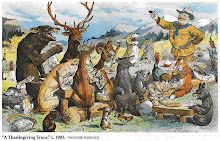Wolverine Way: Snow or Bust
Wolverines, back-country skiers, and cities that depend on water from the mountainous forests of Wyoming, Idaho, Montana, and Washington are in danger of loosing a critical resource this century: snow.
Regional-scale climate projections show that if carbon emissions remain unabated, spring snow cover by the end of this century could decrease by a factor of three to four in Idaho, western Montana, and western Wyoming – according to a recent study published in Environmental Research Letters.
 U.S. Snow Cover Shrinking (Yes, Really)
U.S. Snow Cover Shrinking (Yes, Really)While the study focused its attention on wolverine habitats, the outcome showed that if a reduction in emissions happened quickly, within 10 to 20 years, followed by a rapid decline to zero by the early 2080s – then the snowpack could be saved.
The study provides additional support for last year's recommendation by the U.S. Fish and Wildlife Service to protect wolverines as an endangered species. But with claws (and teeth) that give their species a formidable reputation, the wolverine is not one to stick around and wait for humans to take action.
While the number of wolverines living in America ranges between a few hundred to only a few dozen, it is likely none will stay if the snowpack disappears and summer temperatures also shoot up in excess of 90 degrees Fahrenheit as the climate model also projected in the case of unabated emissions. Wolverines use the spring snow for their dens and keeping their newborn kits warm and protected from predators. More than 15,000 wolverines roam in the cooler regions of Canada.
"It's always possible that a lone wolverine could end up anywhere - they can travel for immense distances," Synte Peacock of the National Center for Atmospheric Research in Boulder, Co., and lead author of the study told Discovery News.
One wolverine was even tracked back to the mountains of Colorado where more used to live, a century ago.
"In the middle of winter, a male wolverine scaled-up the sheer face of Mt. Cleveland, the highest peak in Glacier National Park, climbing about 4,900 feet in 90 minutes," said Peacock, who decided to conduct her study after reading Douglas Chadwick's The Wolverine Way. "I don't know how far a wolverine would go in search of a better climate, but I imagine they could go a long, long way," she said.
IMAGES: Wolverine in a Tree - D. Robert & Lorri Franz/CORBIS; Wolverine growling in Haines, Alaska - Robert Postma/First Light/Corbis.










No comments:
Post a Comment